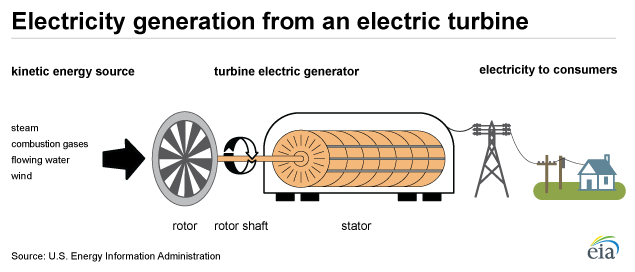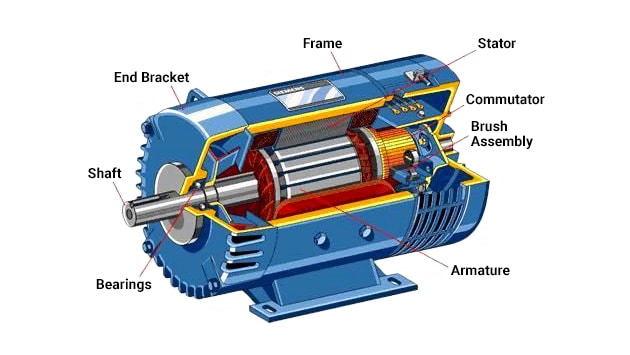A generator creates electricity by converting mechanical energy into electrical energy. This process is achieved through electromagnetic induction.
Generators are essential machines that play a crucial role in providing power in various situations. From emergency backup systems in hospitals to providing electricity in remote areas without access to the power grid, generators ensure continuity and reliability. They work on a simple principle: when a conductor moves in a magnetic field, it induces an electrical current.
This basic concept has revolutionized the way we access and use electricity, making generators a cornerstone of modern infrastructure. Whether it’s for industrial use, commercial applications, or personal convenience, generators offer a dependable solution for meeting electricity needs when traditional sources are unavailable or insufficient. Their versatility and utility make them indispensable in today’s energy-reliant world.

Credit: www.eia.gov
The Basics Of Electrical Generation
The Basics of Electrical Generation begin with understanding how generators convert one form of energy into another. Specifically, they turn mechanical energy into electrical power, a process essential for everyday electricity needs.
From Mechanical Energy To Electrical Power
Generators operate on a simple principle: they convert mechanical energy into electrical energy. The mechanical energy can come from various sources. These sources include steam turbines, water turbines, internal combustion engines, and even hand cranks.
- Steam turbines use steam to produce mechanical energy.
- Water turbines harness the energy of flowing water.
- Internal combustion engines burn fuel to create motion.
- Hand cranks rely on manual power.
The Role Of Electromagnetic Induction
Electromagnetic induction is the key to generating electricity. It involves moving a conductor, like a wire, through a magnetic field. This movement creates an electrical current in the wire.
The main parts of this process include:
| Component | Function |
|---|---|
| Magnet | Creates a stable magnetic field. |
| Conductor | Moves through the magnetic field to induce current. |
| Rotation | Provides the necessary motion for induction. |
Inside A Generator
Generators are fascinating machines. They turn mechanical energy into electricity. Let’s uncover how they work from the inside out.
Key Components Of A Generator
A generator’s core parts are the engine, alternator, fuel system, voltage regulator, cooling, and exhaust systems, lubrication system, battery charger, control panel, and frame. These parts work together to produce electricity.
- Engine – Powers the generator.
- Alternator – Converts mechanical energy to electrical.
- Fuel System – Feeds the engine.
- Voltage Regulator – Controls output voltage.
- Cooling and Exhaust Systems – Manage heat.
- Lubrication System – Reduces friction.
- Battery Charger – Keeps battery charged.
- Control Panel – Monitors operations.
- Frame – Holds everything together.
The Function Of The Rotor And Stator
The rotor and stator are the heart of a generator. They interact to create electricity.
| Part | Function |
|---|---|
| Rotor | Spins inside the stator. |
| Stator | Stays still, has coils of wire. |
As the rotor spins, it moves magnetic fields around the stator. This movement generates electrical current in the stator’s coils. The generator then sends this current out to power devices.
Types Of Generators
Understanding the types of generators is key to choosing the right one. Generators convert mechanical energy into electrical power. Different types cater to various needs.
Portable Vs. Standby Generators
Portable generators offer flexibility and convenience. They are perfect for outdoor activities. Users can move them as needed. They usually support smaller loads.
Standby generators are fixed installations. They provide power during outages. These units automatically switch on during a power loss. They are ideal for homes and businesses.
Fuel Sources: Gasoline, Diesel, And Beyond
- Gasoline generators are common and easy to use. They work well for portable units. Gasoline is readily available.
- Diesel generators are known for durability. They handle larger loads well. Diesel fuel offers a longer shelf life.
Other fuel sources include:
| Fuel Type | Use Case |
|---|---|
| Natural Gas | For homes with a gas line |
| Propane | Cleaner burning option |
| Bi-Fuel | Versatile and efficient |
| Solar | Eco-friendly, no fuel needed |

Credit: www.electricgeneratorsdirect.com
The Science Behind Generators
Let’s dive into The Science Behind Generators. Generators seem magical. They turn motion into electricity. But how? It’s all about science. Let’s explore this.
Faraday’s Law Of Electromagnetic Induction
Faraday’s Law is key. It explains how electricity is made. When a coil moves through a magnetic field, electricity flows. It’s like magic, but it’s science.
- A coil of wire moves.
- It crosses a magnetic field.
- Electricity starts to flow.
This simple action powers our world. Imagine that!
The Importance Of Magnetic Fields
Magnetic fields are invisible forces. They make generators work. Without them, no electricity.
- Magnets create a magnetic field.
- This field pushes electrons.
- Electrons moving create electricity.
Generators use this science to light our homes. Amazing, right?
Power Output And Efficiency
Let’s explore how a generator turns fuel into electricity. We focus on Power Output and Efficiency. This tells us how strong and smart a generator works.
Understanding Kilowatts And Megawatts
Generators have power sizes. We measure them in kilowatts (kW) and megawatts (MW). Think of kilowatts like hundreds of light bulbs. Megawatts are like thousands of light bulbs. Bigger numbers mean more power.
- 1 kW = 1,000 watts
- 1 MW = 1,000,000 watts
Factors Affecting Generator Efficiency
Not all generators work the same. Some are better because they use less fuel. Here are things that make a difference:
- Fuel Type: Gas, diesel, or solar? Each has its own power.
- Age: Newer models are often more efficient.
- Maintenance: Well-kept generators work better.
Remember, a smart generator uses less and does more. It’s like a superhero of electricity!
Practical Applications
Understanding how generators create electricity is one thing. Seeing them in action is another. Let’s explore their practical uses.
Generators In Emergency Power Supply
In times of power outages, generators shine. They provide electricity when the grid fails. Hospitals use them to keep life-saving equipment running. Homes rely on them during natural disasters.
- Hospitals: Continuous power for medical devices
- Homes: Lighting and heating during blackouts
- Businesses: Operations keep going without interruption
Generators In Remote Locations
Remote areas lack grid access. Generators are their power solution. They help in construction, and power cabins and research stations.
| Location | Use |
|---|---|
| Construction Sites | Power tools and machinery |
| Cabins | Lighting and appliances |
| Research Stations | Scientific instruments and daily needs |
Safety And Maintenance
Understanding the safety and maintenance of generators is crucial. It ensures longevity and reliability. Proper care prevents accidents and power issues. Let’s explore how to keep your generator in top shape.
Routine Generator Maintenance Tips
Regular upkeep is key for generator performance. Follow these tips:
- Check oil levels regularly and change as needed.
- Inspect air filters and replace if dirty.
- Test battery health to ensure proper start-up.
- Examine coolant levels before each use.
- Keep the area around the generator clean and clear.
- Run the generator monthly to keep it ready.
Safety Protocols To Prevent Hazards
Generators can be dangerous. Stick to these safety rules:
| Do | Don’t |
|---|---|
| Place generators outside, away from windows. | Use generators indoors or in enclosed spaces. |
| Store fuel properly in labeled containers. | Refill a running or hot generator. |
| Install carbon monoxide detectors nearby. | Ignore local codes for generator placement. |
| Use heavy-duty extension cords rated for outdoor use. | Plug generators directly into a home outlet. |
Future Of Electricity Generation
The way we make electricity is changing. New machines and green power sources are key. They help keep our air clean. They also make sure we have power for a long time.
Advancements In Generator Technology
New generators are smarter and stronger. They use less fuel and make more power. Experts are also making them safer. This means fewer accidents.
Generators are now smaller too. You can put one in your home. It will keep lights on during a power cut.
- Smart tech helps save energy
- Stronger parts last longer
- Safe designs prevent problems
Sustainable And Renewable Alternatives
Green power is big news. Sun, wind, and water are clean fuels. They won’t run out like oil or coal. This means we can make electricity without hurting our planet.
| Source | Benefits |
|---|---|
| Solar | Uses sun rays, low cost |
| Wind | Uses air flow, endless |
| Hydro | Uses water force, reliable |
Electric cars and batteries store this clean energy. They help us use it better. We waste less.

Credit: www.youtube.com
Frequently Asked Questions
How Does A Generator Work?
A generator converts mechanical energy into electrical energy through electromagnetic induction, where a coil within a magnetic field rotates to produce an electric current.
What Fuels A Generator?
Generators typically run on various fuels such as gasoline, diesel, natural gas, or propane, depending on the generator type and intended use.
Can Generators Power A Whole House?
Yes, standby generators are designed to power an entire house and automatically activate during power outages to provide uninterrupted electricity.
What Is The Lifespan Of A Generator?
The lifespan of a generator varies but typically ranges from 1,000 to 3,000 hours of use, with proper maintenance extending its service life.
Are Portable Generators Safe Indoors?
No, portable generators emit carbon monoxide and must only be used outdoors, away from windows, doors, and vents to prevent CO poisoning.
Conclusion
Understanding generator functionality clarifies the marvel of electricity creation. We’ve explored its inner workings, from mechanical energy conversion to power output. This knowledge empowers consumers, guiding informed decisions on energy use. Embracing this technology ensures a reliable power supply, enlightening our daily lives.
Let’s harness this potent force responsibly for a brighter future.




